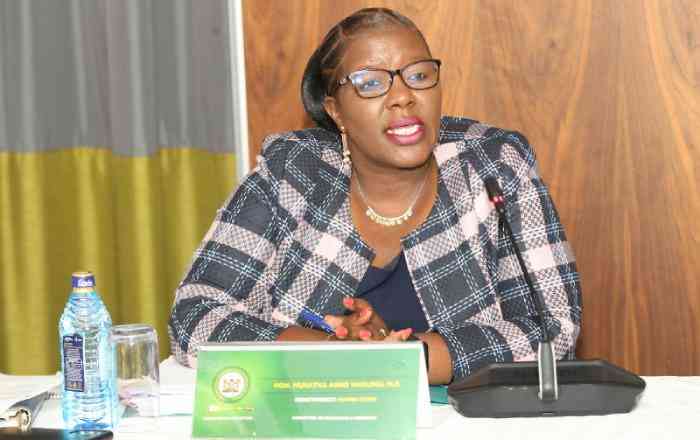In February this year, Makutano village in Ndeiya, Kiambu County, was thrown into mourning after a Form Two student died by suicide.
The body of Mary Wanjiku was found dangling from the rafts of their rental house. Neighbours linked her sudden death to family wrangles. The girl, according to locals, was not in good talking terms with her mother who does manual jobs around the village.
On the fateful day, Wanjiku left her mother at Kandumo shopping centre and went back to their house to prepare lunch for her siblings.
On arrival, the girl requested the siblings to go play outside as she made for them a meal. That was the last time Wanjiku’s siblings saw her alive. Apparently, as they were playing outside while waiting for lunch, the student had locked herself inside and taken her own life using a piece of clothing.
Neighbours assisted police to break into the house where the body was found hanging from the roof.
A month later, another Form Two student from Nguirubi village in Ndeiya also committed suicide by dousing her body with a flammable liquid. It was not clear why Njambi Mungai took her own life, but those who had closely interacted with her said the girl had been exhibiting signs of depression to the extent of failing to report to class.
Growing trend
The two unfortunate incidences highlight a growing trend in Kiambu where young people have been taking their lives. In the recent past, several cases have been recorded in the county leaving residents, opinion shapers, leaders and experts worried as they look for a solution.
Two years ago, the county recorded the highest number of suicides in Kenya. Out of the 483 suicide cases reported as of July, Kiambu alone accounted for 109 of the cases, according to figures released by then Directorate of Criminal Investigation (DCI) boss George Kinoti.

Murangá was second followed by Kisii, Kakamega, Nyeri , Kisumu, Embu, Uasin Gishu while Nakuru, Makueni and Bomet.
Others affected were Kericho, Nyandarua, Machakos, Migori, Narok (nine), Meru (six), Mombasa, Busia, Laikipia, Taita Taveta, Wajir, Homa Bay and Kwale.
There was no suicide incidence in Siaya, Bungoma, Lamu, Tana River, Trans Nzoia and Nakuru counties while Vihiga had not submitted its report when Kinoti shared the data with the public.
Police cited economic hardships due to job and business losses arising from Covid-19 pandemic as the main cause of the suicides. Other factors linked to deaths by suicide include drugs and substance abuse, failed unions and family feuds.
In Kiambu, there is concern that the trend has not stopped with people, especially those still young, frequently committing suicide.
Josphine Waithiru, a counselling psychologist based in the county, says suicide cases have become too common among young men and women.
She is attributing the situation to drugs and alcohol abuse, mental disorders, mood disorders, social isolation and chronic diseases.
Lack of employment
“The association of alcohol and drugs with suicidal thinking and behaviour is both causal and conductive. The subjective state of hopelessness is key to the disposition to actual suicide. Alcohol and drugs are influential in providing a feeling of hopelessness due to the toxic effects of manipulating neurotransmitters responsible for the mood and judgement,” explains Waithiru.
The psychologist is of the view that lack of employment amongst youth has left them developing psychological uneasiness which slowly but steadily leads to stress before degenerating into the depression stage where suicidal thoughts are high.
“The youth through counselling should be made to understand that a career is not their identity, and therefore the need to separate their self-worth from the job. For instance, losing a job is akin to the Kubler-Ross Model grieving emotions of denial, anger, bargaining, depression and acceptance,” says Waithiru.
According to Waithiru, the wave of suicide cases in Kiambu with an estimated of 2.5 million people, should worry everyone, and the matter should not be treated lightly.
“Hopelessness among the youths here is breeding self-hate and guilt, which then snowballs into either fatigue, irritability and insomnia. At this stage, individuals could easily isolate themselves from the world, eventually committing suicide,” she states.
The psychologist is calling on both county and national governments to enhance the Psychosocial support programmes among vulnerable groups.
The World Health Organisation (WHO) says more than 700 000 people die due to suicide every year with death by suicide being the fourth leading cause of death among those aged between 15 and 29 years old.
Seventy-seven per cent of global suicides says WHO, occur in low and middle-income countries where ingestion of pesticides, hanging and firearms are among the most common methods of suicide.
“Suicide is a serious public health problem; however, suicides are preventable with timely, evidence-based and often low-cost interventions. For national responses to be effective, a comprehensive multi-sectoral suicide prevention strategy is needed,” says WHO.
Mental, emotional toll
In Kiambu, the deaths are having a toll on families and communities left behind as they struggle to cope with the loss of their loved ones.
Kiambu Woman Representative Ann Wamuratha is concerned with the worrying trend. She says hopelessness is driving youth to the edge.

“We are here in Nyathuna today and statistics show that the village has lost up to 14 youths in a very short time, eight months to be precise and this is very worrying,” said Wamuratha during the burial of Robert Gituhu, the engineering graduate from the University of Eldoret who set himself ablaze in Mombasa.
The 27-year-old had severally complained of a lack of employment after graduating in 2021. A close relative disclosed that Gituhu had been diagnosed with mental illness, a problem that he developed while he was studying.
Wamuratha says it is not enough selling hope to youth while discouraging them from hovering around shopping centres, associating with bad influence, and partaking in drugs and alcohol.
The lawmaker is proposing the creation of more Technical and Vocational Education and Training (TVET) institutions in the county where youth can be enrolled to acquire relevant skills.
“The deaths have prompted me to come up with the Mama Boys Mashinani; a programme aimed at talking to young men and women in all villages in Kiambu in a bid to give them hope and give them small courses that will prevent them from whiling away time in shopping centers,” says Wamuratha.
Divided into twelve sub-counties of Limuru, Kikuyu, Kabete Lari, Gatundu South, Gatundu North, Githunguri, Kiambu, Kiambaa, Ruiru, Juja, and Thika Town, the main economic activities in Kiambu county are real estate, farming and manufacturing.
Perminus Muiru, a provost at the Anglican Church of Kenya in Kabete, says the church has started counselling sessions among youth following the alarming rate of suicides in the area.
“I wish we had people down in the villages addressing youth issues, in an initiative that should be cascaded up to the national level,” he noted.
Peter Karanja a youth from Nyathuna village, Kabete, says they are frustrated by lack of job opportunities.
Casual jobs
“We are not being given even the simplest jobs like laying of cabros, plastering or tinting windows that now require academic papers. They (employers) are not giving us an opportunity to prove ourselves that we are capable. We don’t have TVETs here that can equip us with skills to jumpstart our lives,” complains Karanja.
According to Karanja, those lucky to get casual jobs that last for only a week, meaning that youths soon find themselves with nothing to do, ending up in drinking dens to drown their sorrows.
A spot check by The Nairobian at Nyathuna, Kingeereo, Wangige, Ngecha, Karanjee and Ndeiya established that most youth report to these centres as early as 7 a.m. where they loiter while imbibing alcohol and drugs.
And the availability of second-hand generation drinks has made the situation even worse. Although authorities are carrying out a crackdown on illicit drinks, young men and women in Kiambu abuse alcohol.